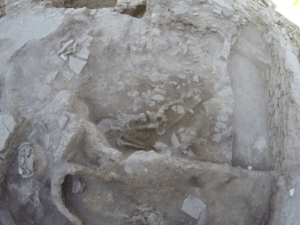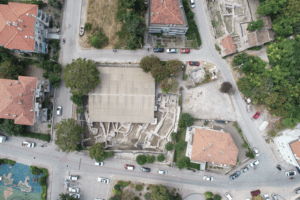
PROCEEDINGS OF THE NATIONAL ACADEMY OF SCIENCES—A study uncovers remains of Late Bronze Age tsunami victims in the Mediterranean. The Late Bronze Age eruption of the Thera volcano on the island of Santorini in the Mediterranean Sea was one of the largest natural disasters in human history. Despite the magnitude of the eruption, remains from human victims have not been identified and evidence of tsunamis is scant. Vasıf Şahoğlu, Beverly Goodman Tchernov, and colleagues performed archaeological and sediment analysis on stratified deposits at Çeşme-Bağlararası in Turkey. The study area encompassed disturbed fortification walls and a layer of rubble and chaotic sediments along with a volcanic ash layer and a bone-rich charred layer. The results include evidence of seawater inundation and building collapse consistent with a series of at least four tsunamis impacting the site. The authors also found articulated skeletons of a young male human and a dog buried in the debris flow. The authors suggest that misshapen pits in the study area were attempts to recover victims from the debris. Calibrated radiocarbon ages suggest that the Thera eruption and subsequent tsunamis occurred no earlier than 1612 BCE. According to the authors, the results illustrate the multigenerational impact of a compound disaster such as the Thera eruption.
________________________________

Excavated skeleton of a tsunami victim. Vasıf Şahoğlu.
________________________________

Aerial view of the Çeşme-Bağlararası archaeological site and surrounding neighborhood. Vasıf Şahoğlu.
________________________________
Article Source: PNAS news release
*“Volcanic ash, victims, and tsunami debris from the Late Bronze Age Thera eruption discovered at Çeşme-Bağlararası (Turkey),” by Vasıf Şahoğlu et al., Proceedings of the National Academy of Sciences, https://www.pnas.org/cgi/doi/10.1073/pnas.2114213118
________________________________
Advertisement




